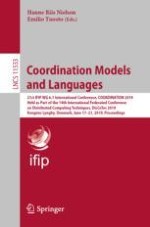2019 | Book
Coordination Models and Languages
21st IFIP WG 6.1 International Conference, COORDINATION 2019, Held as Part of the 14th International Federated Conference on Distributed Computing Techniques, DisCoTec 2019, Kongens Lyngby, Denmark, June 17–21, 2019, Proceedings
Editors: Hanne Riis Nielson, Emilio Tuosto
Publisher: Springer International Publishing
Book Series : Lecture Notes in Computer Science
